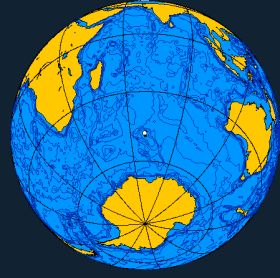The Kerguelen Islanders

The Kerguelen Islands, located in the southern Indian Ocean equidistant between Antarctica, Australia, and the southern tip of Africa, are one of the most remote and isolated spots on earth. High winds average 68 mph year round; cold temperatures and rough seas are the norm.
Kerguelen was discovered by the French explorer Yves-Joseph de Kerguelen-Trémarec in 1772. The Kerguelen Islands were visited by the British Challenger expedition in 1874. Since 1949, French scientific teams have maintained a constant presence of 50 to 100. The main base and "capital" is Port-aux-Français. The islands, which consist of the main island of Grande Terre and 300 small outlying islands, are administered as a district in the French Southern and Antarctic Lands. Total land area is 2,577 square miles.
The native Kerguelen Islanders, or Kerguélenois, number about 6,000. They are physically one of the most distinctive peoples in the world, though due to their extreme remoteness, they have almost completely escaped the notice of anthropologists until recent years. Bourbaki [2003] writes:
The Kerguélenois tend toward medium-tall height and slender build, with an average height of 1.77 meters. The skull is long and markedly dolichocephalic; dark brown eyes, often with an epicanthic fold; long thin aquiline nose; and moderately broad lips. The hair is fairly straight, brown tending toward chestnut or russet. But the most distinctive physical feature of the Kerguélenois is their skin color, which could be described as a medium to medium-light plum or wine color— almost a light purple, and rather pellucid.Bourbaki notes that the Kerguélenois "cannot really be classified as closely related to any other peoples in the world; it is immediately obvious, and closer study confirms, that they are neither negroid, caucasoid, mongoloid, capoid, nor australoid." The native Hakuamanei or Kerguélenois language is also unrelated to any language group in the outside world.
The only close relations to the Kerguelen Islanders are the native inhabitants, today little more than a thousand in total, of other small islands in the south Indian Ocean: Heard and McDonald Islands, the islands of Amsterdam and St. Paul, the Crozet Islands, and the Prince Edward Islands. These small groups closely resemble the Kerguélenois physically and linguistically. It has been hypothesized that the ancestors of the Kerguélenois made the crossing to the remote islands of the south Indian Ocean more than 10,000 years ago. "Certainly there has been a marked genetic drift," remarks Bourbaki. "Preliminary genetic mapping tests indicate remote kinship with the Khoisan peoples of southern Africa, but there are also genetic similarities with archaic Asian peoples such as the Ainu. This would seem to indicate ancestors who wandered down from Asia through Africa many, many millennia ago."
Most of the Kerguélenois still pursue their traditional way of life, living largely on a diet of fish; bird meat, including penguin; seal meat; edible moss; and the Kerguelen cabbage which is native to the islands. Seals also provide fur for the traditional Kerguelender clothing, which is often adorned with feathers. Interaction with the French, which was sporadic to nil until the arrival of the French scientific teams in the late 1940s, remains relatively limited today.
Until the publication of Bourbaki's article, there had been very few references to the Kerguélenois in print, the only extensive popular account, "The Purple-Skinned Kerguelenders," appearing in the December 1963 issue of National Geographic. "This is," says Bourbaki, "a massive lacuna and oversight in anthropological research. The Kerguélenois, remote in frigid subantarctic waters, over 5,000 kilometers from the nearest continental land mass, have remained as far removed from the eye of the modern world as some tribes which dwell deep in the tropical rain forests of the Amazon."
Labels: best_of








2 Comments:
I for one was disappointed in Bourbaki's paper and felt that he had stretched the data to make them fit his anthropological abstractions about "structures of order," "structures of group," and "structures of space." It is reported that he has since admitted that he paid insufficient attention to the combinatorial aspects of the Kerguelenois lifestyle.
Incidentally, I've encountered claims that Richelieu is a Kerguelenois "trying to pass for French" -- with the help of some serious plastic surgery, skin treatments, etc. In my view, it wouldn't be unlike Richelieu to plant this rumor in order, despite obvious appearances, to pass for Kerguelenois.
Well, that would certainly be preferable to Richelieu actually being what I wrote about last April 1...
Post a Comment
<< Home